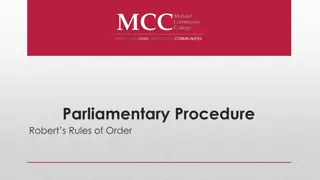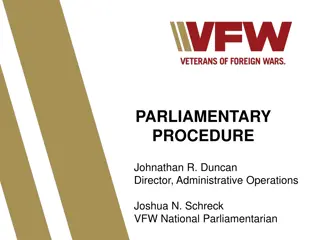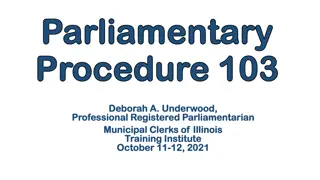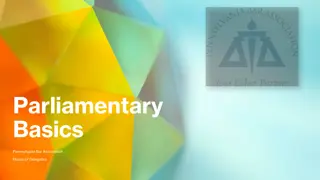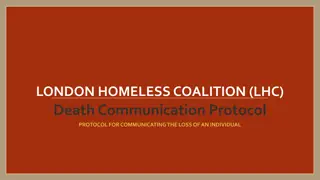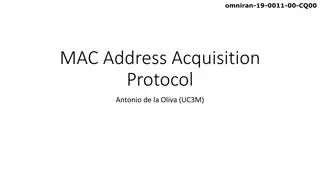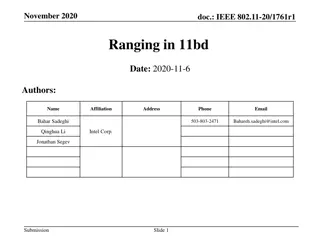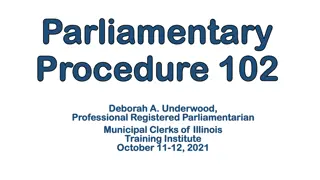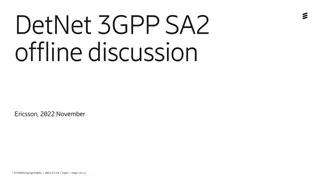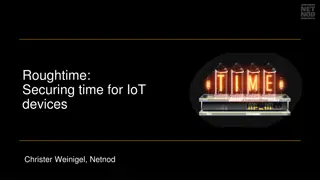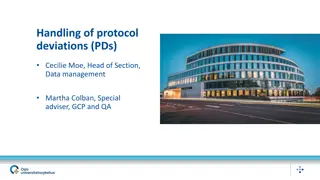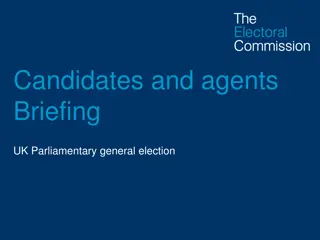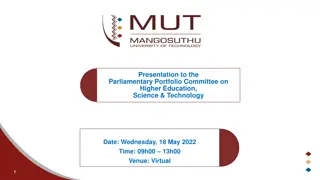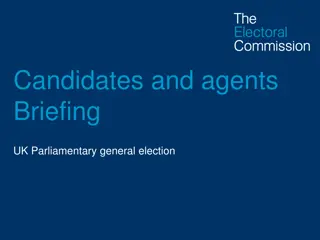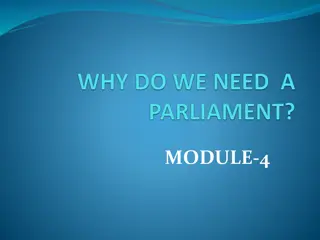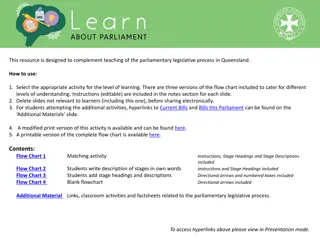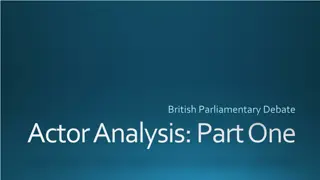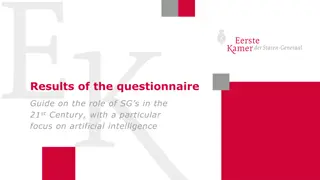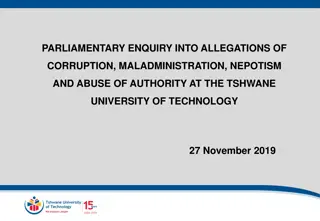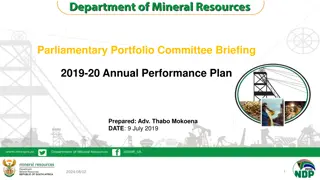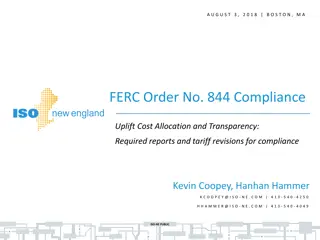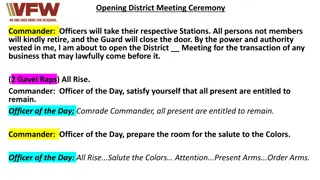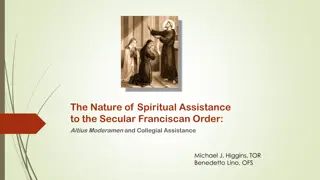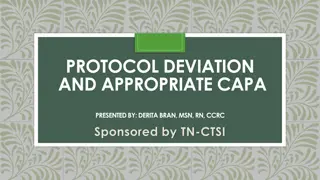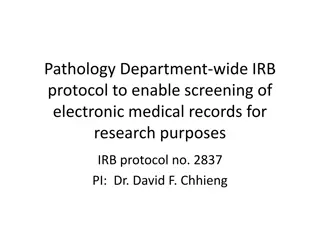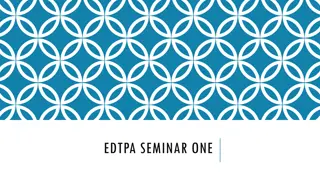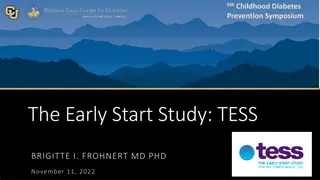Parliamentary Protocol and Order of Business
Learn about the four main objectives of parliamentary procedure, basic principles to follow, the use of the gavel for conducting meetings effectively, and the order of business to ensure smooth proceedings in organizational meetings.
Download Presentation

Please find below an Image/Link to download the presentation.
The content on the website is provided AS IS for your information and personal use only. It may not be sold, licensed, or shared on other websites without obtaining consent from the author. Download presentation by click this link. If you encounter any issues during the download, it is possible that the publisher has removed the file from their server.
E N D
Presentation Transcript
Parliamentary Procedure Parliamentary Procedure Four objectives of Parliamentary Procedure: 1. Only one subject at a time may be dealt with. This facilitates the transaction of business. 2. Extends courtesy to everyone. Promotes cooperation and harmony. 3. Observes the rule of majority. Ensures that all members have equal rights, privileges and obligations. 4. Ensures the rights of the minority. Even if the majority has the right to decide, the minority has the right to be heard.
Basic Principles Basic Principles A quorum must be present for the group to act. As defined by the by-laws If not, then majority of membership Only one question should be considered at any given time. No member should speak until recognized by the chair. The chair should maintain strict impartiality during discussion. Chair can vote if it will affect the outcome
Use of the Gavel Use of the Gavel One Tap of the Gavel 1. Tells members to be seated 2. Used to signify the passage or failure of a motion 3. Used to adjourn a meeting
Use of the Gavel Use of the Gavel Two Taps of the Gavel 1. Brings the meeting to order
Use of the Gavel Use of the Gavel Three Taps of the Gavel 1. Signal for all members to stand This may be to vote, in opening ceremonies or during the salute to the American Flag.
Order of Business Order of Business The order of business helps members keep on track in taking care of business. An agenda is an order of business for each specific meeting. An agenda should be established for each meeting prior to the meeting.
Order of Business Order of Business Order of Business as stated in the Official FFA Manual: Opening Ceremonies should be conducted, including the call to order, roll call, and quorum determination. Minutes of Previous Meeting should be prepared and presented by the secretary and approved by the members as read or as amended. Officer s Report The treasurer s report should be given at every meeting.
Order of Business Order of Business Special Features speakers, panels, guest appearances, award presentations, other non-business items should be at the beginning. Unfinished Business designed to resolve motions postponed or tabled at previous meeting. Committee Reports presented by representatives from standing and/or special committees subject to acceptance by the membership.
Order of Business Order of Business New Business Proposes new items of business to the chapter. Items include those on the meeting agenda and others introduced by chapter members. Ceremonies used only when new members are initiated, Discovery FFA Degrees awarded, FFA Degree promotions, officer installations. Closing Ceremonies Preceded by final announcements, bringing the official meeting to a formal and dignified close.
Order of Business Order of Business Entertainment, Recreation, and/or Refreshments As planned by the recreation committee and should follow the meeting to increase interest in attendance.
Characteristics of a Presiding Officer Characteristics of a Presiding Officer It is the duty of the chair (President) to see that the rules of order are followed democratically without favoritism. All matters receive adequate discussion. The decisions made by the meeting are reflective of the careful judgement of the voting majority.
Characteristics of a Presiding Officer Characteristics of a Presiding Officer Specific Rules are: 1. Call the meeting to order 2. State the business on the agenda which needs to be dealt with 3. Recognize members wishing to speak 4. Should be familiar with parliamentary law
Characteristics of a Presiding Officer Characteristics of a Presiding Officer Common Sense Rules: 1. Fair Play Fair-minded moderator to all members 2. Avoid Confusion Chair decides who has the floor 3. To the Point See to it that members are brief and to the point when speaking 4. Talk Loud Don t shout, but loud enough for all to hear 5. Decisions on important matters should be made with thorough discussion from all sides of the question
General Rules of the Assembly General Rules of the Assembly A Quorum should be present at any meeting where business is to be conducted. Quorum The minimum number of members required to be present in order for business to be transacted. The chair should determine quorum before meeting. Usually it is one member over 50% of the total membership. The bylaws could state that business could be conducted with a different total, such as 10% of the active membership. But this must be stated clearly in the bylaws of the organization.
Main Motion Main Motion A Main Motion that is one of the most important kind of motion because it is made for the purpose of getting something done. Any member entitled to vote at the meeting may propose any action that can properly be taken by that meeting.
Main Motion Main Motion Member rises or raises his hand and addresses the Chair. Mr./Madam President or Chairperson. Chair recognizes the member. Member states: I move that _______ (states motion). Second to motion (not necessary to stand or be recognized). The Chairman may have to ask, Will anyone second this motion? I second the motion. If no one is willing to 2ndmotion, the motion is dropped for lack of a 2nd and proceed to the next order of business.
Main Motion Main Motion Chair states motion: It has been moved by (name) and seconded that _________. (Repeated by the chair so that everyone can hear it distinctly) Is there any discussion on the motion? The floor is now open for members to discuss.
Discussion Discussion If debatable, every member has right to debate Chair refrains from debate while presiding Proposer of motion has first right of debate Must be related (germane) only to motion on the floor A member can only speak twice on the same question during the same day
Main Motion Main Motion When it is time to close debate on a motion (other than previous question) The Chair says: If there is no further discussion, we shall proceed to vote on the motion which is _______(restate motion).
Voting on Motion Voting on Motion Vote: The Chair says, All those in favor of ______(the motion is stated) say aye. Those opposed say no. If motion requires 2/3 vote, ask for rising or by show of hands. Should always ask for those opposed. Result of the vote is stated by chair. The motion is carried or the motion is lost. If counted vote, give number on both sides
A Tie Vote A Tie Vote A tie vote is a failed vote President/chair does not have to break a tie unless specified in bylaws President/chair can vote to make or break a tie vote The chair can vote anytime it will affect the outcome
Privileged Motions Privileged Motions Privileged motions is the category of motions that relate to the privileges of members and must be handled immediately. As such, privileged motions rank higher in precedence than any other category of motions. The first 13 motions in the chart of permissible motions are ranked by order of precedence. There are only two that pertain to the Conduct of Meeting contest.
Raise a Question of Privilege Raise a Question of Privilege A motion that allows a member to make an individual request, or a request on behalf of the assembly that deals with the immediate comfort or convenience of the assembly. It is not debatable It is not amendable It does not require a second A member can interrupt a speaker to move Question of Privilege The chair makes the decision on Question of Privilege (No vote)
Raise a Question of Privilege Raise a Question of Privilege Example: Member: I rise to a question of privilege affecting the assembly. Chair: State your question. Member: May we dim the room lights so we can see the agenda on the projector screen? Chair: Your request is well-taken. Please dim the meeting room lights.
Recess Recess Recess is a short break in the meeting. It is not debatable. It is amendable (Possibly with the length of the recess) It does require a second. A member may not interrupt a speaker to move to recess. Requires a majority vote to pass.
Recess Recess Example: Member: I move to recess for 5 minutes. Chair: It has been moved and seconded to recess for 5 minutes. This is a privileged motion that is not debatable and amendable. Are there any amendments? (Pause). Hearing none we will now proceed to vote. All those in favor say AYE. All opposed NAY. Motion (passes/fails). Could recess to a specific time (6:00 p.m.) or until ordered by the chair.
Subsidiary Motions Subsidiary Motions Subsidiary motions rank below privileged motions, and above the main motion in order of precedence. The purpose of the subsidiary motion is to help dispose of the main motion by either amending, voting, postponing, or killing the motion. There are 7 subsidiary motions on the chart of permissible motions. 5 subsidiary motions can be part of the Conduct of Meeting contest.
Previous Question Previous Question When an assembly is discussing a motion and a member wishes to close debate and proceed to vote on the immediately pending motion, or all pending motions, he/she may move previous question. If passed, debate on the motion stops, and the assembly proceeds to a vote. It is not debatable It is not amendable It requires a second A member may not interrupt another member who has the floor. It requires 2/3 vote to pass.
Previous Question Previous Question Example: Member: I move previous question on all pending motions. (Second) Chair: Previous question has been moved and seconded. Those in favor of ordering previous question on all pending motions please rise. Be seated. Those opposed, please rise. Be seated. There are 2/3rds in the affirmative and previous question is ordered on all pending motions. Proceed on voting on all pending motions starting with the most recent presented to the assembly.
Postpone Definitely Postpone Definitely If it appears that a pending motion should be delayed to a more appropriate time, a member may move to postpone to a certain time (or postpone definitely). It is debatable It is amendable It requires a second You can not interrupt another speaker that has the floor. Requires a majority vote to pass.
Postpone Definitely Postpone Definitely Example: Member: I move to postpone the motion to the next regularly scheduled meeting. (Second) Chair: It has been moved and seconded to postpone this motion to our next regularly scheduled meeting. The motion to postpone to a certain time (definitely) is amendable, debatable, and requires a majority vote to pass. Is there any discussion?
Commit or Refer Commit or Refer If an assembly agrees that a pending motion needs further research and possible improvement, it may commit or refer the motion to a smaller group of members that make up a committee. It is debatable It is amendable It requires a second A member may not interrupt a speaker who has the floor. Requires a majority vote to pass.
Commit or Refer Commit or Refer Example: Member: I move that the motion be referred to a committee of seven to be appointed by the chair and report back at our next regular meeting. (Second) Chair: It is moved and seconded to refer the motion to a committee of seven to be appointed by the chair. This motion is amendable, debatable, and requires a majority vote to pass. Is there any discussion?
Amend Amend If an assembly agrees that a pending motion can be improved, it can adopt to change or amend the motion. The motion to amend is one of the most common tools used by an assembly (and in contest). It is debatable (Only if it is applied to a debatable motion.) It is amendable It requires a second A speaker may not interrupt a speaker who has the floor. Requires a majority vote to pass.
Amend Amend There are three basic processes of an amend: 1. Adding or inserting words or paragraphs to a motion on the floor. 2. Striking out words or paragraphs from a motion on the floor. 3. Striking out words and inserting words, in other words, substituting words or paragraphs to the existing motion on the floor. A motion that is amendable can be amended twice. The first motion is considered the Primary amendment. A primary amendment can be amended, which would result in a Secondary amendment.
Amend Amend Remember that discussion must remain germane to the motion on the floor. (It must relate to the immediate motion on the floor.) Remember that the member who moved to amend has the right to speak first on the amendment. Example: Member: I move to amend the main motion by adding the words, at our agricultural education building. (Second) Chair: It has been properly moved and seconded to amend the main motion by adding the words, at our agricultural education building. This is amendable, is debatable, and requires a majority vote to pass. Is there any discussion?
Amend Amend If there is no discussion, remember that it is important that the chair restate the amendment and reads the motion how it will be as amended. Example: Chair: Is there any discussion? Seeing none we will now proceed to vote on the amendment which adds, at our agricultural education building so that the main motion as amended would read, ( ). All those in favor say AYE. Those opposed NAY. Amend passes/fails. The main motion that the amendment was attached to still has to be voted on after the amendment(s) have been voted on.
Postpone Indefinitely Postpone Indefinitely If a main motion, or voting for a motion is perceived as undesirable, an assembly may adopt the motion to postpone indefinitely to kill the motion and avoid voting. It is debatable It is not amendable It requires a second A member may not interrupt another speaker who has the floor Requires a majority vote to pass
Postpone Indefinitely Postpone Indefinitely Example: Member: I move that the motion to ( ) be postponed indefinitely. (Second) Chair: It has been moved and seconded that the motion ( ) be postponed indefinitely. This is not amendable, is debatable, and requires a majority vote to pass. Is there any discussion? Seeing none, we will now proceed to vote. All those in favor of postponing the motion to ( ) please say AYE. All opposed say NAY. Motion passes/fails.
Incidental Motions Incidental Motions As the name implies, incidental motions are the class of motions that occur incidentally in relation to other motions or procedures. As such, incidental motions are not ranked in order of precedence. They are typically moved on and quickly disposed. There are 3 motions that are part of the conduct of meeting contest.
Parliamentary Inquiry Parliamentary Inquiry It is one of the fundamental rights of members to receive information about parliamentary procedure. Parliamentary inquiry is a question directed to the chair relating to parliamentary law or other rules. It is not debatable It is not amendable It does not require a second A member can interrupt a speaker who has the floor Chair decision on the motion. No vote taken
Parliamentary Inquiry Parliamentary Inquiry Example: Member: Madam/Mr. President, I rise to a parliamentary inquiry. Chair: You may state your inquiry. Member: What vote does the pending motion to amend require? Chair: The pending motion to amend requires a majority vote? Member resumes his/her seat.
Division of Assembly Division of Assembly A member may demand a division of assembly if he or she feels like the voice vote did not indicate a clear affirmative or negative vote on the pending question. It is not debatable It is not amendable It does not require a second A member may interrupt another member who has the floor. The chair can complete a division of assembly without permission of the assembly and any member can demand it.
Division of Assembly Division of Assembly Example: Chair: All those in favor say AYE. (pause) All opposed say NAY. (pause) Member: Division! Chair: Division of Assembly has been called for. All those in favor of the amendment please stand. Be seated. Those opposed please stand. Be seated. Madam/Mr. Secretary the count? Thank you. The amendment passes/fails.
Point of Order Point of Order The intention of a point of order is to receive a ruling from the chair on a particular breach in parliamentary rules. However, if a chair is unsure of the ruling, he or she may put it to a vote. It is not debatable It is not amendable It does not require a second A member may interrupt another member who has the floor Chair decides. Usually no vote is taken.
Point of Order Point of Order Example: Scenario: Member 1 makes an amendment. The states the question, and then opens the floor for debate. All members rise Instead of calling for Member 1, the chairman calls on Member 2. Member: Point of Order Chair: State your Point of Order Member: I move point of order that I made the motion to amend and therefore should have the right to debate first on this motion. Chair: Your point is well taken. Member 2 will please take his/her seat, and Member 1 has the floor.
Set Up for Meeting Set Up for Meeting Remember that the set up for the Conduct of Meeting contest is different than it is for Opening and Closing Ceremonies.
Set Up of Meeting Set Up of Meeting President Podium
Sample Conduct of Meeting Sample Conduct of Meeting Click Here to view video of Conduct of Meeting Contests Click Here to view video of Conduct of Meeting Contests
Questions Questions True or False. Parliamentary Procedure allows an assembly to deal with more than one subject at a time. False (Only one subject at a time may be dealt with to facilitate the transaction of business.)







